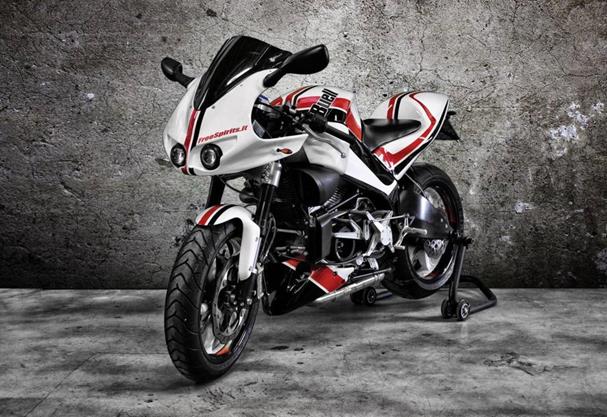
The Buell Motorcycle Company is one of the most iconic brand that marked the marketplace of motorbikes for its peculiarities and innovations. Its motorcycles are definitely different from any others, but very often they are also misunderstood.
Erik Buell founded the Buell Company in 1987 at Mukwonago, Wisconsin. He was an engineer for Harley Davidson when he decided, together with 11 other collaborators, to leave the well-known American company to start creating some brand-new motorcycles, completely out of the standards.
The philosophy that Erik Buell would like to give to his own motorcycles was: driving simplicity for any riders, independently to their abilities.
Due to a bunch of problems inherent the marketplace and their marketing strategies, during the first years the Buell Company straggled to established itself. After 3 years from when Erik founded the Company, the economic situation wasn’t at its best and the future for the brand was uncertain.
During this period of difficulty, Harley Davidson intervened to save the factory, buying 51% of the stock package. Harley became to all effects the owner of the Buell, which came back into the Harley Davidson’s family, while the other 49% of the stock package remained in Erik Buell’s hands.
The first motorcycles made by Buell were revolutionary, thanks to the basic law which Erik used to follow: the so-called “trilogy of technology”:
With this philosophy, Buell tried to reduce all those factors that made the Harley Davidsons difficult to ride on narrow streets. He tried to create motorcycles with Harley engines but more manageable and agile.
Concentrating as much as possible the masses at the centre of the motorcycles, the engineer Buell tried to limit the transfers of loads in order to improve the agility of the motorcycle. When we brake, in fact, the fork of our motorcycle sinks and the weight is shared more on the front of the bike than the rear. This shift of weight requires some time to stabilize, while the fork sinks. If we maintain the weight on the centre of the motorcycle, there will be less pendulum effect and the transfers of loads will be faster; consequently, we will be able to bend the motorcycle faster.
When we talk about unsuspended masses, instead, we are referring to all those masses which are in contact with the asphalt in a more or less direct way; so, everything which joins the wheel’s mass: tire, rim, brake discs and callipers, part of the fork and swing arm and so on. Greater are these masses and more stable will be the motorcycle on straight, but lower will be the possibility to move easily the motorcycle on turns. This whole rotating mass, in fact, create a gyroscopic effect which maintains the motorcycle upright on straight. This effect is as greater as higher is the speed of rotation of the wheels. Reducing this weight, we will be able to tilt the motorcycle in an easier way and using less strength; so, we will have a more manageable and rapid bike on turns and changes of direction.
In the same way, a stiffer frame makes the motorcycle quicker and faster on direction changes.
When we are bent in the curves the motorcycle is inflected like a wooden bench while we are sitting in the middle. The more the bike is inflected, the less the frame and the swing arm are rigid and more the bike is stable on curves. However, it might be difficult to change direction if we have a very inflected motorcycle, so we would have to push a lot on the footboards and handlebars. In Erik’s philosophy, where motorcycles are imagined for sports use on streets, the ease to inflect with the bike from one side to the other was fundamental to be fast, especially to make all riders comfortable while they are driving.
Erik focused its studies in this direction and created some revolutionary motorcycles, using, for example, the space between the swing arm and the frame as a tank of petrol and oil or introducing perimeter disc brakes which are connected to the outside of the rim instead of the centre. In this way there is more braking surface, reducing at minimum the inertia of the disk.
The engines used have always been Harley Davidson’s engines, from the Sportster series, except for the first used by Buell in some American races between the 70s and the 80s. The engines provided by Harley were always processed and improved by the engineer Buell, who was able to obtain 100 CV from the same engine which delivered 60 CV on the Sportster.
The first motorcycle manufactured by Buell was the RR1000, that adopted the Harley XR 1000 engine, but was more powerful, faster and easier to use. It obtained a great result, capable to supplant the XR by Harley Davidson, which almost immediately came out of production.
In 1989, starting from the same bases, Buell manufactured the RR 1200 with an increase in engine displacement and a more modern engine. In 1990 with the model RS 1200 the chassis was revisited for a more city use, and a double saddle was mounted in order to host a passenger.
Unfortunately, the 30th October 2009, the American company was forced to close the Buell, due to the economic crisis and the collapses of the sales. A story long 26 years came to an end, even if it was sprinkled by successes and innovations, where a lot of innovative motorcycles were manufactured and designed by expert hands, maybe too expansive and particular for the masses, but loved and understood by the lovers and experts of the sector.
Today the brand still collects great success and the used ones keep high their quotation, because the request of the market is always high for these motorcycles and there are more passionate who have the desire to own a part of Buell story.

© 2023 Free Spirits s.r.l. P.iva 03285260240 – R.E.A. Num. 313422 – Cap. Soc. € 10.000,00 int.vers. – CCIAA di Vicenza
Some accessories in this catalog may not conform to the law of your country, we recommend that prior to the sale or installation, consult the Highway Code itself.
© 2022 Free Spirits s.r.l. P.iva 03285260240 – R.E.A. Num. 313422 – Cap. Soc. € 10.000,00 int.vers. – CCIAA di Vicenza
Some accessories in this catalog may not conform to the law of your country, we recommend that prior to the sale or installation, consult the Highway Code itself.